Caramel sauce is a luscious and versatile dessert topping that has captivated taste buds around the world for generations. It’s a rich and decadent sauce made by melting and caramelizing sugar until it turns a deep amber color, resulting in a sweet and slightly bitter flavor profile. Caramel sauce is not only a delightful drizzle over ice cream, cakes, and puddings, but it’s also an essential ingredient in a variety of delectable desserts like caramel flan, caramel apples, and caramel-filled chocolates. Its golden hue and irresistible sweetness make it a beloved treat that can elevate your desserts to a whole new level of deliciousness. Whether you’re a seasoned chef or a home baker, learning how to make your own caramel sauce can unlock a world of dessert possibilities, and it all begins with the magic of caramelization.

What Is Caramel Sauce?
Caramel sauce is a sweet and decadent dessert topping made primarily from sugar that has been melted and caramelized. It is known for its rich, golden-brown color and its irresistible sweet and slightly bitter flavor. The process of making caramel sauce involves heating sugar until it liquefies and transforms into a deep amber or brown color, creating a complex and indulgent taste.
Caramel sauce can be customized by adding ingredients like butter, cream, or flavorings such as vanilla or sea salt. These additions enhance its texture and flavor, resulting in variations like salted caramel sauce or butterscotch sauce.
This versatile sauce is used to drizzle over a wide range of desserts, including ice cream, cakes, pies, pancakes, waffles, and puddings. It can also be used as a filling or flavoring in various confections and beverages, making it a beloved ingredient in the world of desserts and sweets. Whether used as a topping, dip, or ingredient, caramel sauce adds a touch of indulgence and sweetness to a wide array of culinary creations.
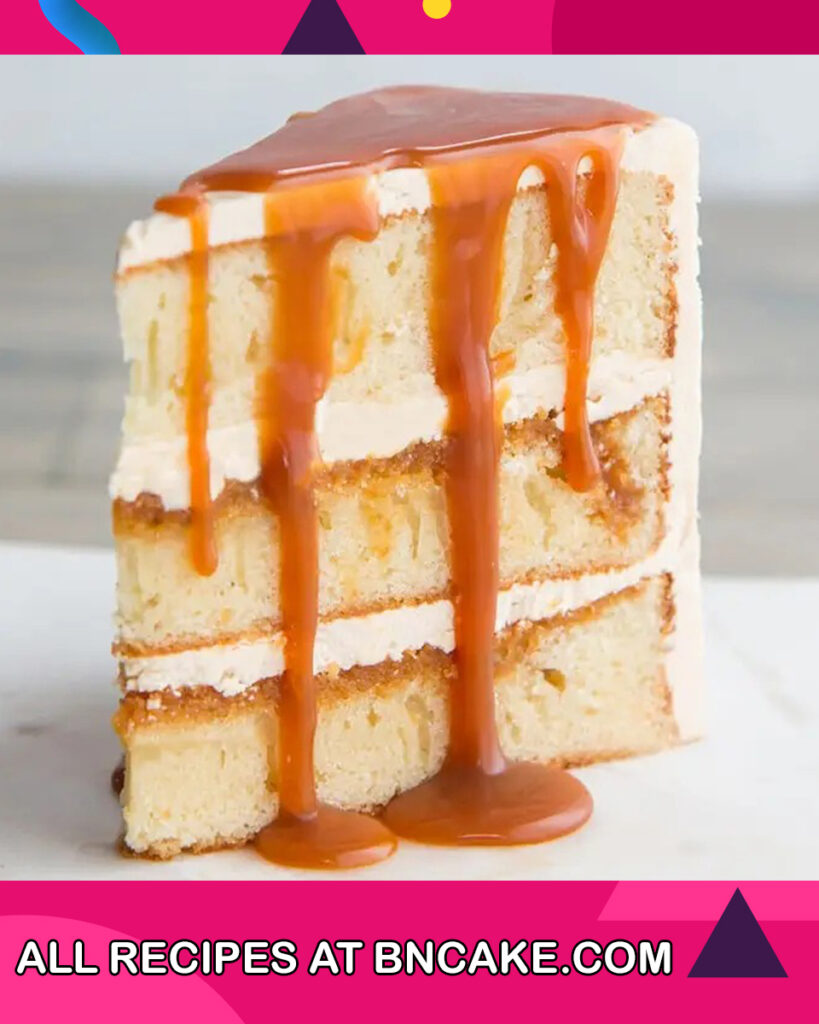
Why You Will Love Caramel Sauce Recipe?
- Irresistible Flavor: Homemade caramel sauce boasts a deep, rich flavor that’s superior to store-bought versions. The combination of caramelized sugar, butter, and cream results in a delectable balance of sweet and slightly bitter notes.
- Versatility: Caramel sauce is incredibly versatile. You can use it as a topping for ice cream, drizzle it over cakes and desserts, or use it as a filling for chocolates and pastries. Its adaptability allows you to get creative in the kitchen.
- Homemade Goodness: Crafting your caramel sauce from scratch is a rewarding experience. It’s a culinary skill that you can be proud of, and the aroma and taste of freshly made caramel sauce are unbeatable.
- Customization: With a homemade recipe, you can customize your caramel sauce to your preferences. Adjust the level of sweetness, add a pinch of sea salt for salted caramel, or incorporate flavor extracts like vanilla or bourbon for unique variations.
- Impress Guests: Serving desserts drizzled with homemade caramel sauce is an impressive way to delight your guests. They’ll appreciate the extra effort and savor the incredible taste.
- Gift-Worthy: Homemade caramel sauce makes a thoughtful and delicious gift. Package it in decorative jars or bottles, and you have a delightful present for friends and family.
- Ingredient Control: When you make caramel sauce at home, you have complete control over the ingredients. You can choose high-quality butter, cream, and sugar, making it a healthier option compared to some store-bought alternatives with added preservatives.
- Endless Uses: Beyond desserts, caramel sauce can enhance breakfast items like pancakes and waffles, or even be used as a flavorful drizzle for savory dishes like roasted vegetables or grilled meats.
- Culinary Creativity: Experiment with different variations of caramel sauce, such as adding spices like cinnamon or incorporating unique flavors like espresso or coconut. Your creativity can lead to mouthwatering discoveries.
- Warm Comfort: Enjoying a warm batch of homemade caramel sauce can be a comforting and indulgent experience, perfect for cozy evenings or special occasions.
Overall, making your own caramel sauce allows you to savor the magic of caramelization and create a sweet, versatile, and truly delectable addition to your culinary repertoire.
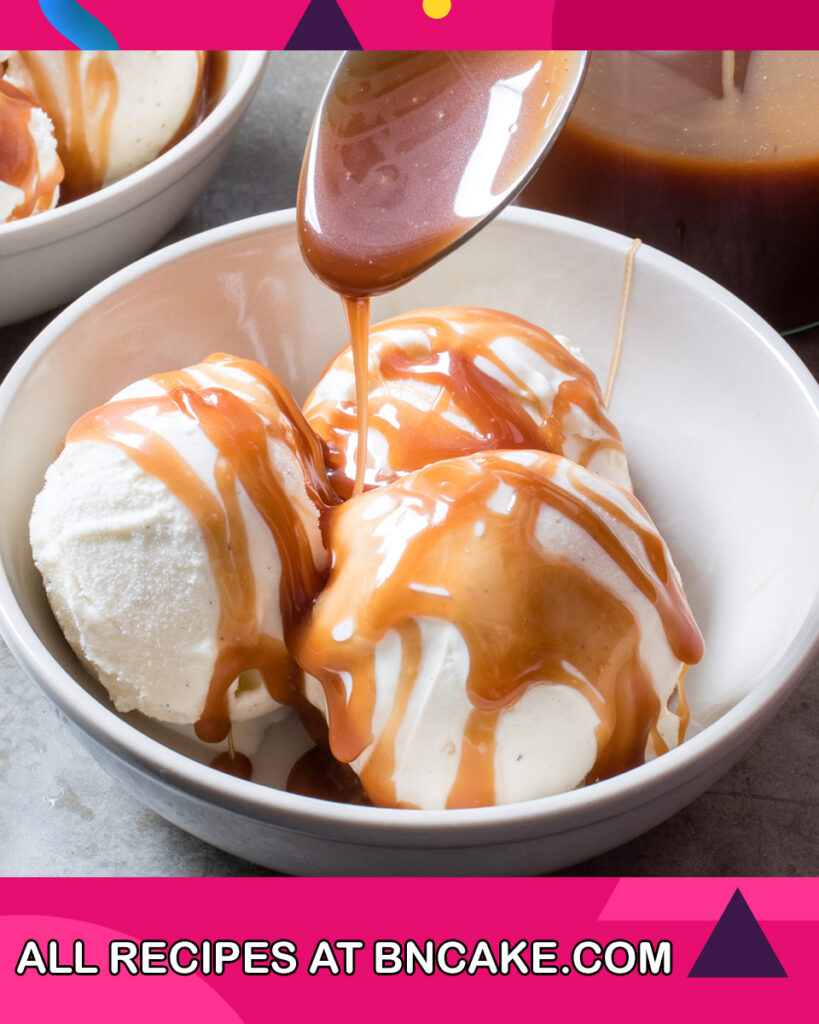
Ingredients For Caramel Sauce
- 1 cup granulated sugar
- 6 tablespoons unsalted butter
- 1/2 cup heavy cream (or whipping cream)
- 1 teaspoon pure vanilla extract (optional)
- A pinch of salt (optional, to taste)
Additional Notes:
- You can adjust the quantity of butter and cream slightly to achieve your desired consistency and flavor. More butter will yield a richer and creamier sauce, while less will result in a thinner sauce.
- The addition of vanilla extract enhances the caramel sauce’s flavor, but it’s optional. You can also experiment with other flavorings like almond extract or bourbon for unique variations.
- A pinch of salt helps balance the sweetness and can be added to taste.
These measurements are for a basic caramel sauce recipe. You can easily double or halve the quantities depending on your needs. Making caramel sauce at home is a simple process, and with these ingredients, you’ll be on your way to enjoying a rich and delicious topping for your desserts.
How To Make Caramel Sauce
- Prepare Your Ingredients: Before you start, measure out all the ingredients and have them ready, as caramel sauce requires quick and careful handling.
- Melt the Sugar: In a heavy-bottomed saucepan, heat the granulated sugar over medium heat. Stir continuously with a wooden or heat-resistant spoon until the sugar starts to melt. Keep stirring until all the sugar has liquefied and turned a deep amber color. Be careful not to burn the sugar; it can go from golden to burnt quickly.
- Add the Butter: Once the sugar is caramelized, add the unsalted butter. The mixture will bubble up, so be cautious. Stir the butter into the caramelized sugar until it’s fully melted and combined. This step will give your caramel sauce its creamy texture.
- Pour in the Cream: Slowly and carefully pour the heavy cream into the saucepan while stirring constantly. Again, be cautious, as the mixture will bubble up vigorously. Continue to stir until the caramel sauce is smooth and well combined.
- Optional Flavorings: If you’d like to add vanilla extract or any other flavorings, do so at this point. Stir them into the sauce until fully incorporated.
- Adjust Salt (Optional): Taste the caramel sauce and add a pinch of salt if desired. Salt can enhance the caramel’s flavor by balancing the sweetness. Adjust to your taste preference.
- Cool and Store: Remove the saucepan from heat and allow the caramel sauce to cool slightly. It will thicken as it cools. Once it reaches your desired consistency, you can transfer it to a glass jar or airtight container for storage.
- Serve: Caramel sauce can be served warm or at room temperature. Drizzle it over ice cream, cakes, pies, or any dessert of your choice. It’s also a delightful dip for apple slices or as a sauce for various sweet treats.
Now you have a homemade caramel sauce that’s perfect for enhancing your favorite desserts or enjoying on its own. Experiment with different variations and enjoy the delicious sweetness of your creation!

How To Serve Caramel Sauce
Caramel sauce is a versatile and delightful topping that can enhance a wide range of desserts and sweet treats. Here are some ways to serve and enjoy caramel sauce:
- Drizzle Over Ice Cream: One of the classic uses for caramel sauce is as a topping for ice cream. Pour warm caramel sauce over your favorite ice cream flavors, and it will create a heavenly combination of hot and cold, creamy and sweet.
- Dress Up Cakes and Pies: Caramel sauce pairs beautifully with cakes, pies, and tarts. Drizzle it over slices of cheesecake, chocolate cake, apple pie, or pecan pie to add an extra layer of flavor and elegance.
- Enhance Dessert Plates: Create decorative designs or swirls of caramel sauce on dessert plates to add a touch of sophistication to your presentation. It’s an excellent way to make desserts visually appealing.
- Dip for Fruit: Use caramel sauce as a dip for fresh fruit, such as apple slices, pear wedges, or banana chunks. The combination of sweet caramel and crisp, juicy fruit is delightful.
- Pancake and Waffle Syrup: Caramel sauce can replace traditional syrups on your pancakes or waffles. It adds a unique and rich flavor that pairs well with breakfast foods.
- Stir into Coffee or Hot Chocolate: Stir a spoonful of caramel sauce into your morning coffee or hot chocolate for a sweet and indulgent treat.
- Top Off Puddings: Add a drizzle of caramel sauce to rice pudding, bread pudding, or tapioca pudding to elevate the flavor profile.
- Cake Filling: Spread caramel sauce between cake layers as a delicious filling. It pairs exceptionally well with chocolate or vanilla cakes.
- Decorative Garnish: Use caramel sauce to create decorative patterns or swirls on dessert plates, or garnish individual desserts with a drizzle for an elegant finishing touch.
- Creative Dessert Creations: Get creative by incorporating caramel sauce into dessert recipes. It can be used as an ingredient in cookies, brownies, or even homemade caramel-flavored lollipops.
Remember that caramel sauce can be served warm or at room temperature, depending on your preference and the dessert you’re pairing it with. Its rich and sweet flavor is sure to delight your taste buds and elevate your dessert experience.

How To Store Caramel Sauce
Properly storing caramel sauce is essential to maintain its quality and prevent it from spoiling. Here are some guidelines for storing caramel sauce:
1. Cool to Room Temperature: After making caramel sauce, allow it to cool to room temperature before storing it. This helps prevent condensation from forming inside the container.
2. Airtight Container: Transfer the cooled caramel sauce to an airtight container or a glass jar with a tight-fitting lid. Make sure the container is clean and dry.
3. Refrigeration (Optional): Caramel sauce can be stored in the refrigerator for extended shelf life, especially if you’ve added dairy products like butter or cream. While it’s not necessary, refrigeration can help prevent spoilage and maintain freshness for up to a few weeks.
4. Room Temperature Storage: If you prefer to store caramel sauce at room temperature, it can be kept in a cool, dark pantry or cupboard. Ensure that the storage area is away from direct sunlight and heat sources.
5. Seal Container Properly: Whether refrigerating or storing at room temperature, ensure that the container is tightly sealed to prevent air and moisture from entering. This helps maintain the sauce’s texture and flavor.
6. Label and Date: It’s a good practice to label the container with the date of preparation, especially if you plan to store caramel sauce for an extended period. This way, you can keep track of its freshness.
7. Reheating: If your caramel sauce becomes too thick or crystallizes during storage, you can gently reheat it. Place the container in a bowl of hot water or microwave it in short intervals, stirring until it returns to a smooth consistency.
8. Check for Spoilage: Before using stored caramel sauce, inspect it for any signs of spoilage, such as mold, off odors, or unusual texture. If you notice any of these signs, it’s best to discard the sauce.
Caramel sauce is a relatively stable condiment, but its shelf life can be influenced by factors like the quality of ingredients used and the cleanliness of storage containers. Refrigeration is the safest option for prolonging its freshness, but many people successfully store caramel sauce at room temperature without issues for short periods.
Ultimately, the choice between refrigeration and room temperature storage depends on your preferences and how quickly you plan to use the caramel sauce.
Recipes that Use Caramel
Tips And Tricks For Caramel Sauce
Making perfect caramel sauce can be a rewarding experience, but it does require some care and attention. Here are some tips and tricks to help you master caramel sauce:
- Use a Clean Saucepan: Make sure your saucepan is clean and dry before you start. Any impurities or residue can affect the caramelization process.
- Equal Size Ingredients: If you’re using cold butter and cream, cut them into small, uniform pieces before adding them to the hot caramel. This helps them incorporate smoothly.
- Stir Constantly: Stir the sugar continuously with a wooden or heat-resistant spoon as it melts to ensure even caramelization. Avoid scraping the sides of the saucepan, as sugar crystals can form and cause the caramel to crystallize.
- Be Patient: Caramelization takes time. Be patient and let the sugar melt and turn amber gradually. Rushing this process can result in uneven caramel or burning.
- Use a Candy Thermometer: For precision, use a candy thermometer to monitor the temperature of the caramel. You’re looking for a temperature around 350-360°F (177-182°C) for a deep amber color and rich flavor.
- Safety First: Be cautious when adding butter and cream, as the caramel can bubble vigorously. Stand back a bit and pour slowly.
- Controlled Pouring: When pouring in cream and butter, do it slowly and gradually. This prevents the sauce from splattering and helps it emulsify smoothly.
- Add Flavorings Carefully: If you’re adding flavorings like vanilla extract or spices, do so once the sauce is off the heat and has cooled slightly. Adding them too early can cause splattering.
- Salt to Taste: If you’re making salted caramel sauce, add a pinch of salt at the end and adjust to your preferred level of saltiness. Salt enhances the caramel flavor.
- Reheating: If your caramel sauce thickens or crystallizes during storage, you can gently reheat it in the microwave or a saucepan over low heat. Add a bit of cream if needed to reach your desired consistency.
- Label and Date: If you’re storing caramel sauce, label the container with the date of preparation. This helps you keep track of its freshness.
- Experiment: Don’t be afraid to experiment with different variations, such as adding spices (cinnamon, nutmeg), liqueurs (bourbon, whiskey), or using brown sugar for a unique flavor profile.
Remember that practice makes perfect when it comes to caramel sauce. It might take a few tries to get the caramelization just right, but the result is worth the effort. Enjoy your homemade caramel sauce in various desserts and treats!
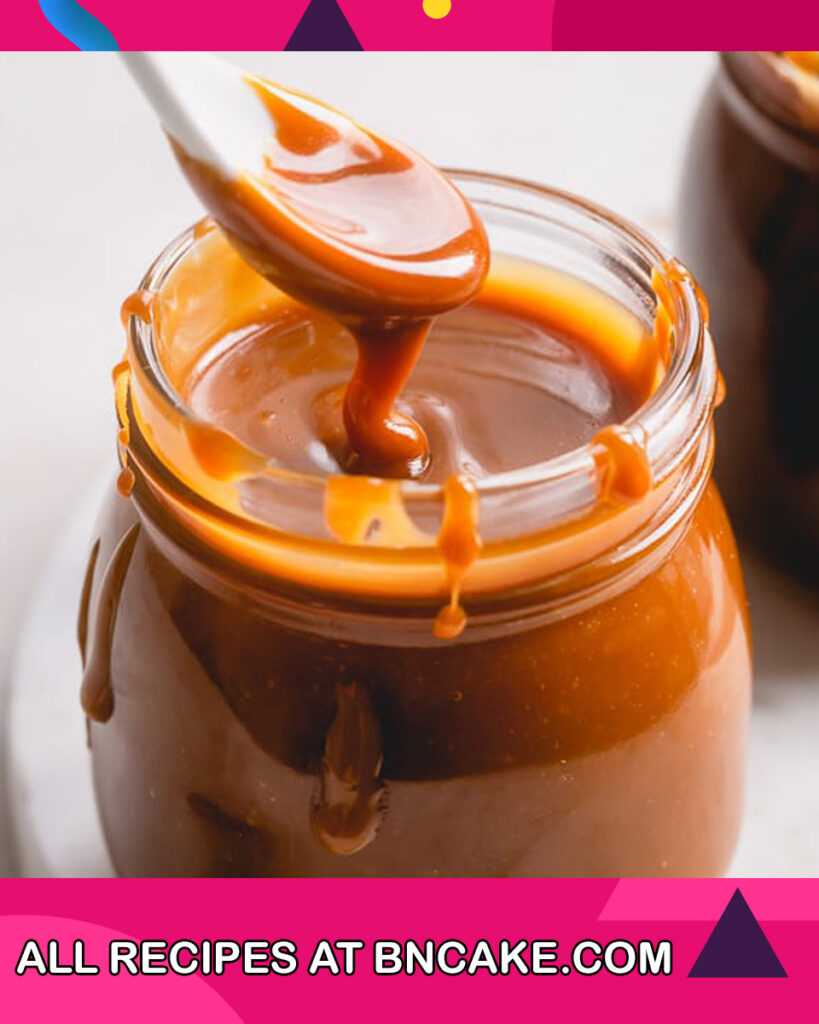
FAQs And Troubleshooting
1. Why did my caramel sauce crystallize?
- Crystallization can occur if sugar crystals form during the cooking process. To prevent this:
- Start with clean, dry cookware.
- Avoid scraping the sides of the saucepan while the sugar is melting.
- Add a bit of acid (a small amount of lemon juice or cream of tartar) to the sugar before cooking. This can help inhibit crystallization.
2. Why did my caramel sauce burn?
- Caramel can quickly go from golden to burnt if not watched carefully. To prevent burning:
- Use medium heat and stir continuously.
- Remove the saucepan from the heat as soon as the caramel reaches your desired color.
3. My caramel sauce is too thick. How can I thin it out?
- If your caramel sauce is too thick, you can easily thin it by adding a bit of cream or milk. Heat the sauce gently and whisk in small amounts of cream until it reaches your desired consistency.
4. My caramel sauce is too thin. How can I thicken it?
- To thicken a thin caramel sauce, you can simmer it gently over low heat to evaporate some of the moisture. Be patient and stir occasionally until it thickens to your liking.
5. Can I reheat caramel sauce?
- Yes, you can reheat caramel sauce if it has thickened or crystallized during storage. Reheat it gently in the microwave or on the stove over low heat, adding a little cream or milk if needed to reach your desired consistency.
6. How do I store caramel sauce?
- Store caramel sauce in an airtight container in the refrigerator for longer shelf life, or at room temperature if you plan to use it within a week or so. Ensure the container is tightly sealed to prevent moisture from entering.
7. Can I make caramel sauce without cream or butter?
- While traditional caramel sauce recipes include cream and butter for a rich texture and flavor, you can make a dairy-free caramel sauce by using alternatives like coconut milk or almond milk and plant-based butter substitutes.
8. Is it possible to make caramel sauce with brown sugar?
- Yes, you can make caramel sauce with brown sugar for a different flavor profile. Keep in mind that it will have a deeper, molasses-like taste compared to white sugar caramel.
9. Can I make caramel sauce in advance?
- Yes, you can make caramel sauce in advance and store it in the refrigerator for several weeks. Be sure to label and date the container for reference.
10. What can I do with leftover caramel sauce?
- Leftover caramel sauce can be used in a variety of ways, such as drizzling it over pancakes, stirring it into coffee or hot chocolate, using it as a dip for fruit, or incorporating it into dessert recipes like brownies or cheesecakes.
Remember that caramel sauce can be a bit finicky, especially if you’re new to making it. Don’t be discouraged by initial challenges, as practice will help you become a caramel sauce pro.
Nutrition Information
Caramel sauce is a sweet and indulgent condiment primarily made from sugar, butter, and cream. The nutrition information for caramel sauce can vary depending on the specific recipe and serving size. Here’s a general idea of the nutritional content of caramel sauce per 2-tablespoon (30-gram) serving:
Calories: Approximately 120-130 calories, Total Fat: Around 7-8 grams, Saturated Fat: Approximately 4-5 grams, Carbohydrates: About 15-16 grams, Sugars: Around 15-16 grams, Protein: Minimal, typically less than 1 gram, Sodium: A small amount, usually less than 50 milligrams
Please note that these values can vary based on the amount of butter, cream, and sugar used in your specific recipe. If you have dietary restrictions or are concerned about the nutritional content, you can consider making modifications, such as using lower-fat ingredients or reducing the sugar content.
Keep in mind that caramel sauce is primarily used as a topping or drizzle for desserts, so serving size plays a significant role in determining the overall nutritional impact. Enjoy caramel sauce in moderation as a delicious treat to enhance your desserts and sweets.

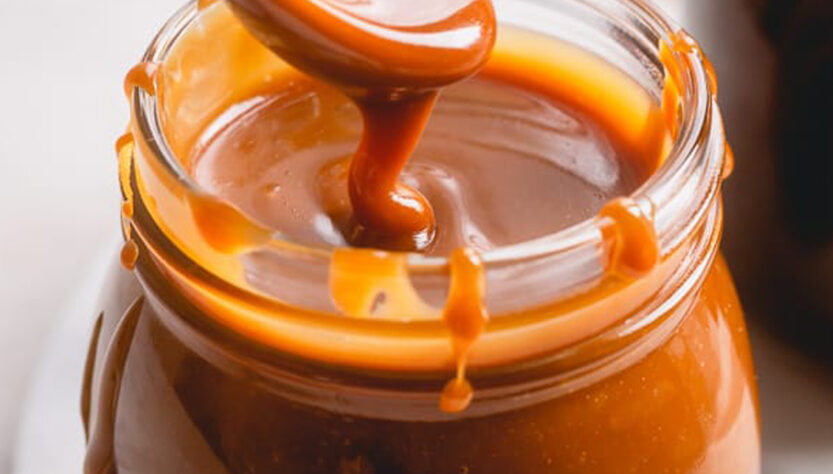
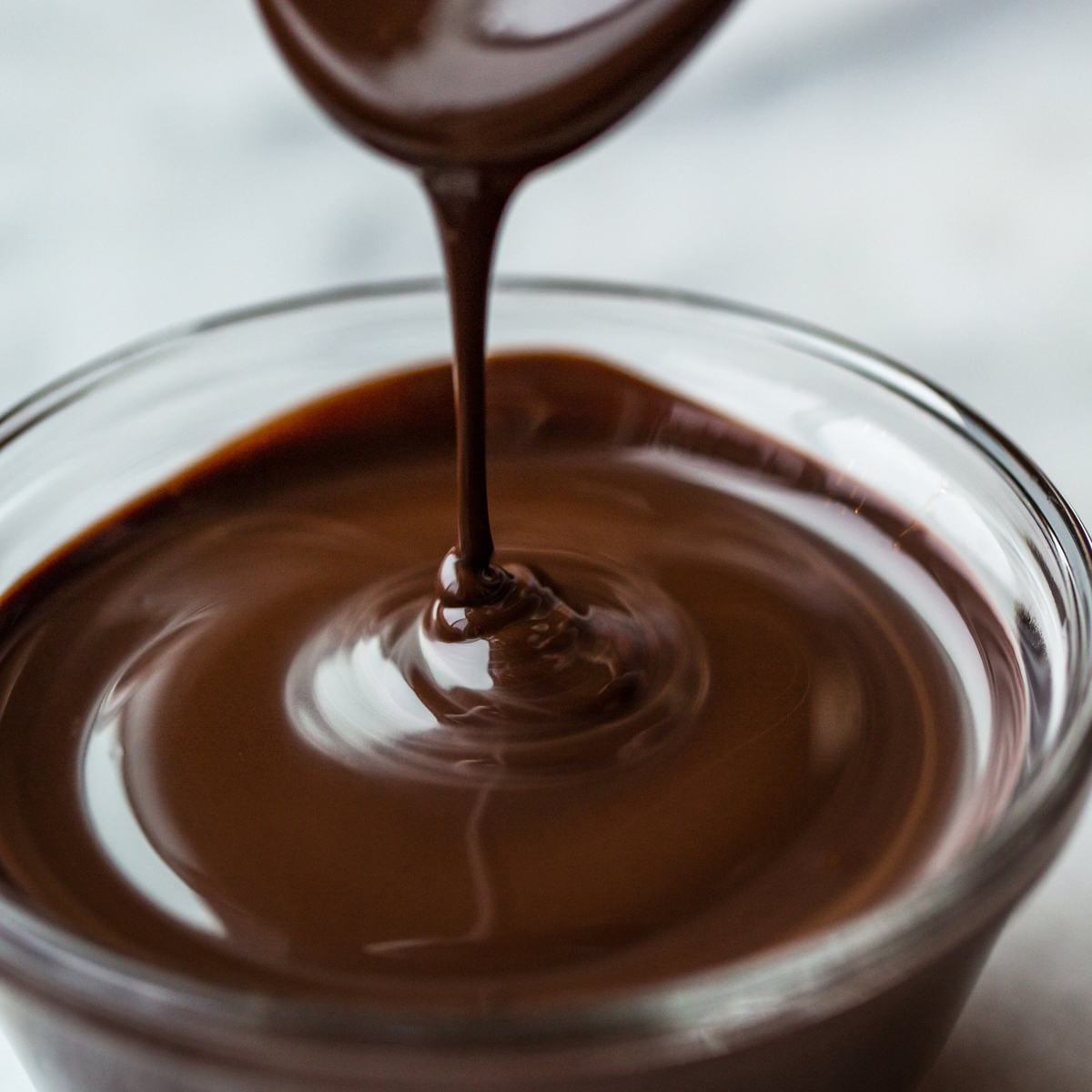

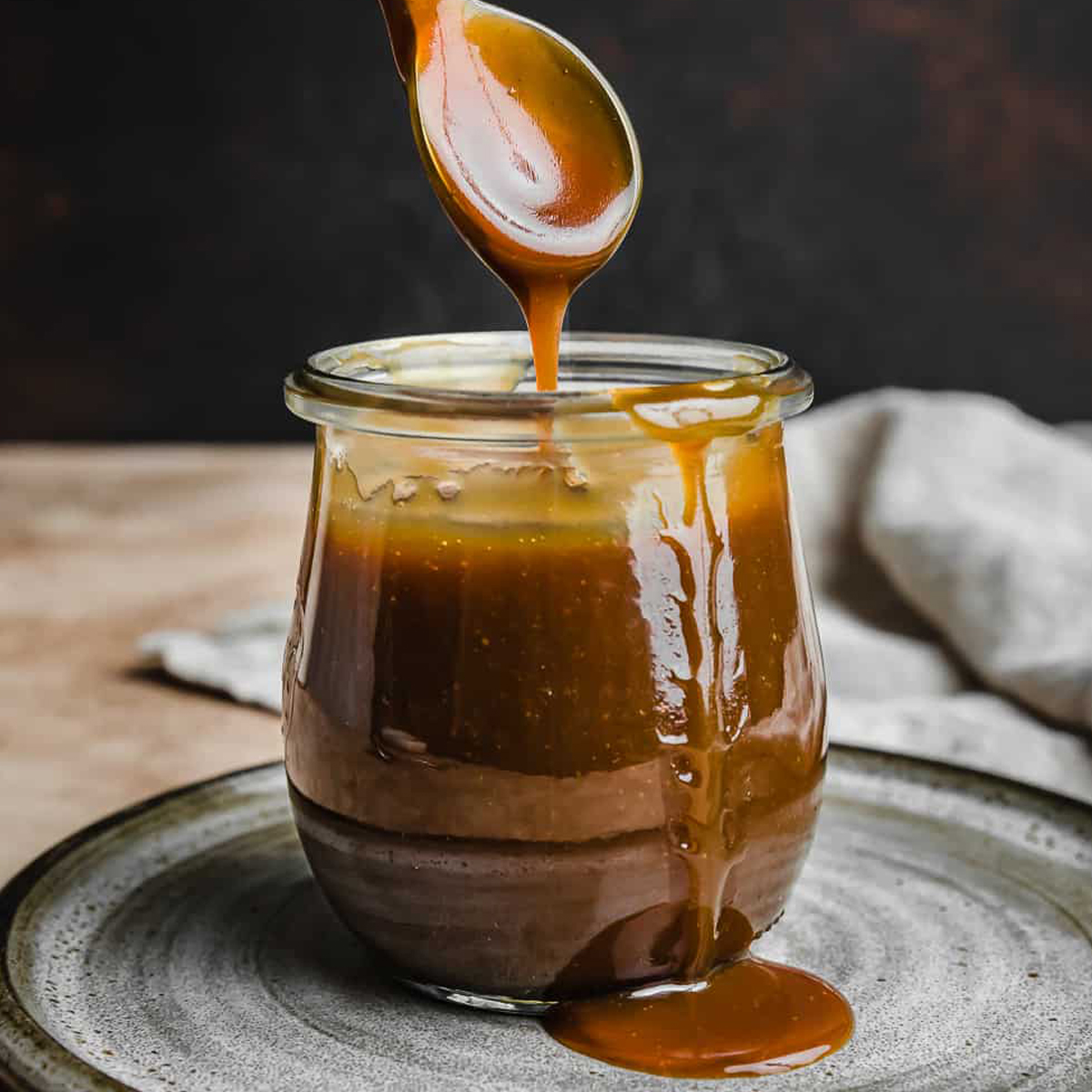
Could you translate the recipe into grams please? Thank you